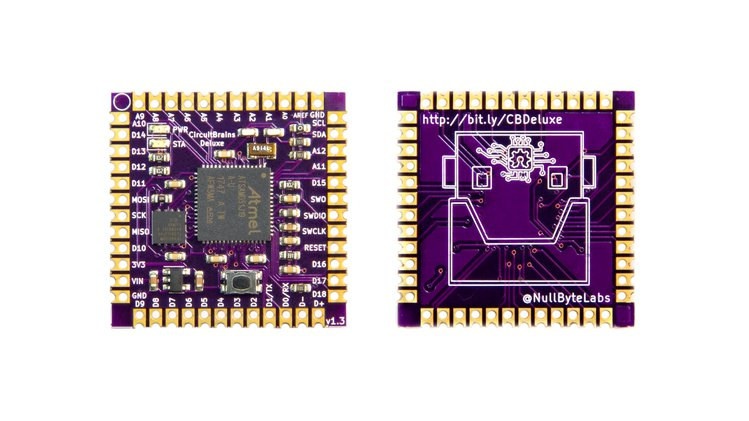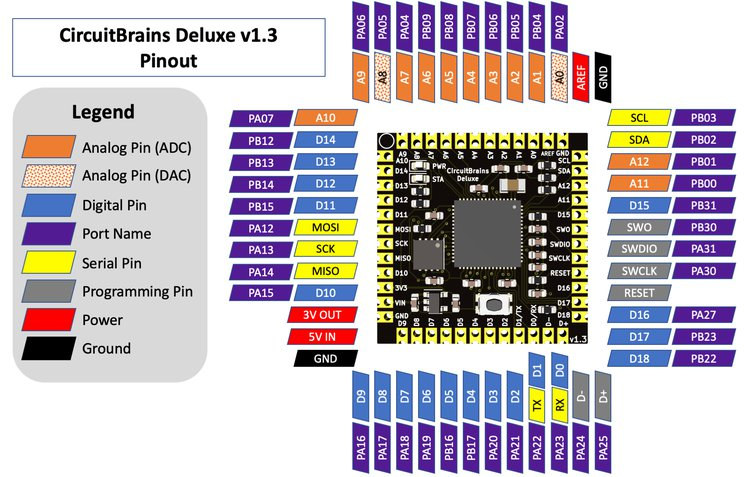 There are plenty of boards with Adafruit’s CircuitPython support, but Microchip SAMD51 powered CircuitBrains Deluxe is a little different since it’s a module with castellated holes that make it easy to solder to your own baseboard or integrate into a space-constrained product.
There are plenty of boards with Adafruit’s CircuitPython support, but Microchip SAMD51 powered CircuitBrains Deluxe is a little different since it’s a module with castellated holes that make it easy to solder to your own baseboard or integrate into a space-constrained product.
CircuitBrains Deluxe specifications:
- MCU – Microchip/Atmel ATSAMD51J19 32-bit ARM Cortex M4 microcontroller @ 120 MHz with 192 KB SRAM, 512 KB Flash
- Storage – 8 MB Quad SPI Flash
- I/Os via 48x through holes and castellated holes around the module
- GPIO (13 Analog, 2 of which are DAC capable, and 19 Digital)
- SPI, I²C, UART
- SWD programming/debug interface
- USB D- & D+
- Power
- Supply Voltage – 5V
- Output – Onboard 3.3 V 600 mA Linear Regulator (LDO) connected to 3V3 pin
- Dimensions – 29 x 29 x 3.5 mm

The module comes preloaded with CircuitPython, a fork of MicroPython maintain by Adafruit. You can just connect the board over USB to access the serial console and storage, modify your code, and see the results as soon as you save the changes. The developer is also working on supporting Arduino.
Besides its small size, CircuitBrains Deluxe has other advantages over larger CircuitPython compatible boards such as Adafruit Feather M4 Express, Adafruit Metro M4 or Sparkfun Thing Plus. It exposes more I/Os, and offers 8 MB SPI flash against 2MB or 4MB for competing boards. You’ll find the KiCad hardware design files on Github.
The project has very recently launched on Crowd Supply with a $4,800 funding goal. Three rewards are available with one, two or three modules for respectively $29, $55 and $80. Shipping is free to the US, and $10 to the rest of the world, and actual shipping is scheduled for the end of July 2020.

Jean-Luc started CNX Software in 2010 as a part-time endeavor, before quitting his job as a software engineering manager, and starting to write daily news, and reviews full time later in 2011.
Support CNX Software! Donate via cryptocurrencies, become a Patron on Patreon, or purchase goods on Amazon or Aliexpress





It would be nice to offer a similar module but with a protected USB-C connector already installed. I think all future boards should use USB-C, but most have very close spacing making installation on a PCB overly complex for most people.
It would be nice if the power (USB), GND and USB Data were in the same corner, then it might be possible to make a daughter board mounting above or below the module holding the connector, ESD protection and reverse voltage protection in a small PCB.
This add-on scheme could also be extended to a battery charger circuit.
29 bucks, it is expensive. nowaday we have rt10xx board powered with nxp uc cortex m7 at lower price, that has much perfomance at lower cost
I don’t get it. It looks impossible to use standalone, inconvenient to prototype with, and pointless for production. It’s a simple enough circuit to replicate, basically just all the standard stuff that you can practically just copy the circuits from the SAM51’s datasheet, and it’s printed on just a 2-layer pcb and doesn’t look like it needs very tight minimum trace sizes so any board being made to use these castellated modules could just as easily just print the circuit directly on the board anyway.
I do like that they took the time to make the pinout be grouped kind of logically, and I’m sure it’s a little easier to use their port of circuitpython rather than having to define your own pin mappings and compile a custom version, but I just don’t really see much reason for it.
This looks like it’s 2.54mm pitch so maybe it’ll be just right for people that are building stuff up on those cheap green proto boards.. The problem is it’s a bit expensive so you probably don’t want to solder it into a prototype. Especially with all sides soldered it’ll be a pain to remove.
If it was ~$3 like some of the really cheapy micro boards you could solder it into a prototype and just buy another instead of trying to recover it.